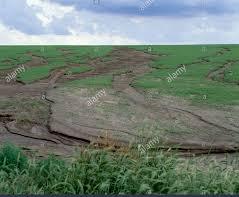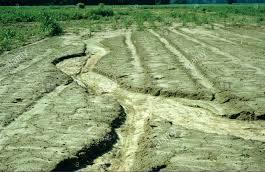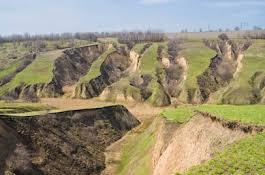WHAT IS SOIL EROSION- TYPES & MECHANISM
DEFINITION
Soil erosion is the process of removal or detachment of soil particles from the parent body and transportation of such particles by wind and/or water.
Soil erosion is caused by several erosive agents like water, air, snow, plants, animal and humans. Therefore depending on the agents of erosion, soil erosion is classified mainly as water erosion & wind erosion.
In the process of soil erosion three distinct actions are involved–
- Detachment of particles,
- Movement and
- Deposition of detached particles.
WATER EROSION
The characteristic soil losses due to water erosion are as follows:
- Sheet Erosion- This is first step of erosion in which top thin layer of soil is removed from land along with runoff water.

Sheet erosion from heavy rain - Rill erosion– This is second step where particles are detached by surface flow into series of rills which are small, parallel channels.

Reel Erosion - Gully Erosion- Gullies are formed due to increased channelization of runoff. It is transformation of unchecked rills into gullies and leads cultivation difficult if unchecked.

Gully erosion - Ravines- These are deep and wide gullies formed due to prolonged process of gully erosion.
Factors of Water Erosion:
- Rainfall- The amount, intensity, duration and distribution of rainfall influence runoff and thus influence erosion. Higher the intensity or amount or duration of rainfall or all together causes severe erosion.
- Vegetation- The vegetative cover of soil is very important that affects the erosion. that’s why soil erosion is less under vegetative protection. Type of vegetation, canopy and heights influence the interception of rainfall and thus extent of erosion. The impact of raindrops is absorbed by vegetation and as a result there is no breakdown of soil aggregates. Besides plant roots also bind the soil particles.
- Soil- Soil characteristics such as topography and physical, chemical, biological properties of soil greatly influence the soil erodibility. Soil topography is most important character that influences runoff and transportation of sediments. Besides degree and length of slope also determine the amount of runoff and extent of erosion. Soil structure and soil texture affects detachability and transportation of soil particles. Type of soil like sandy soil, sandy loam detach easily but due to heavy weight transport slowly while with higher clay content of heavy soils, detachment is difficult , but transport is easily due to light weight.
WIND EROSION
The movement of soil particles due to wind blow can occur anywhere and anytime where soil is not compact. This is serious problem on flat land in dry or sandy areas where land is bare and devoid of vegetation.
Mechanism of Wind Erosion– The movement of soil particles due to wind blow takes place in three stages:
- Saltation- The fine sand (0.1-0.5 mm in diameter) jumped into the air due to effect of wind and fall through the air. It is first step of movement of particles and about 50-70% of soil weight is lost by wind erosion carried in saltation.
- Surface Creep- Sand grains larger than 0.5-3 mm in diameter are moved along the ground surface is called surface creep.
- Suspension- The fine particles smaller than 0.1 mm in diameter are floated through the air. They floated in the air, stay in suspension and carry very long distance. About 3-4% of soil weight is lost by wind erosion carried in suspension.
Factors of Wind Erosion
- Climate– Wind velocity is the main agent of wind erosion. Temperature and rainfall are other agents.
- Soil- Soil structure, soil texture, cohesiveness, bulk density, moisture content, organic matter etc. influences wind erosion. In addition soil roughness has considerable effect on wind erosivity of soil.
- Vegetation- Type of vegetation, their height and density affects wind velocity. Bare land devoid of vegetation is susceptible to wind erosion. Wind erosion badly affects the standing crops.
WAVE EROSION
Wave erosion is the result of combined action of wind and water and mainly occurs in river banks and canal.
Read more…
DIFFERENCE BETWEEN CLIMATE & WEATHER
GREEN REVOLUTION IN INDIA- ITS IMPACT
AGRICULTURE IN INDIA: Landmarks,Development & Present Scenario
What is Agriculture & History of Agriculture
SOIL TYPES IN INDIA: FEATURES
SOIL PROFILE- DIFFERENT HORIZONS
SOIL TEXTURE- CLASSIFICATION & INFLUENCE
FORMATION OF SOIL-PROCESS & FACTOR OF SOIL FORMATION
Excellent explanation. Thanks for sharing with us
It is so knowledge full. Kindly Keep posted
Thanks for your valuable comments. trying my best to share the knowledge.